For everything you need to know about buying and maintaining tires, click here.
Quick, name the top two safety features on your car, truck, or SUV. Chances are good that tires didn't factor high among the answers. But tires are your vehicle's sole connection to the road. You need to know one of the simplest things you can do to take care of them, so they can take care of you: periodic tire rotation.
"Most drivers don't pay attention to their tires," says Matt Edmonds, executive vice president at the Tire Rack, the largest online marketplace for tire sales in the United States. While tires are his business, Edmonds is under no illusion that tire rotation, a vitally important safety check, is going to get pulses racing.
That's because car tires can seem, well, kind of boring. Most drivers tend not to notice them unless they get a flat. Tires don't have the panache of self-driving technology, the excitement of rubber-burning horsepower, or the feel-good factor of automated emergency braking and blind-spot-monitoring systems.
Too bad, because tire rotation is important when it comes to maintaining the performance and safety of your vehicle. Your tires are, quite literally, where the rubber meets the road, as your tires' contact patches with the pavement are in use during every single drive, in all weather conditions. Well-cared-for tires keep you safe.
Tire Rack
Buy Now
Tire Rack
Buy Now
Tire Rack
Buy Now
Tire Rack
Buy Now
Depending on whether the vehicle you're driving is front-, rear-, or all-wheel drive, the tires will wear at different rates. The driven wheels have more work to do and often exhibit quicker rates of wear. A front-wheel-drive car, for example, uses its hard-working front wheels to steer, brake, and put the power down to the pavement (all while carrying the added weight of a front-mounted engine and transaxle).
A front-wheel-drive car, for example, uses its hard-working front wheels to steer, brake, and put the power down to the pavement (all while carrying the added weight of a front-mounted engine and transaxle).
“By rotating your tires, you give the tires a chance to even out their wear and get extended life out of your tires,” Edmonds explains. He recommends having your tires rotated about every 3000 to 5000 miles, or at least every time you go in for an oil change. If your owner's manual states that your car doesn't need new oil that frequently, then plan on a tire rotation at least once every six months.
Rotating your tires evens out the wear and makes them last longer.
Proper rotation not only helps even out wear and extend the life of your tires, it provides the perfect opportunity to make certain all four wheels are in good working order. “As we're coming out of winter and going into spring, it's a good time to inspect the tires' outside and inside shoulder for damage, particularly from potholes,” Edmonds says.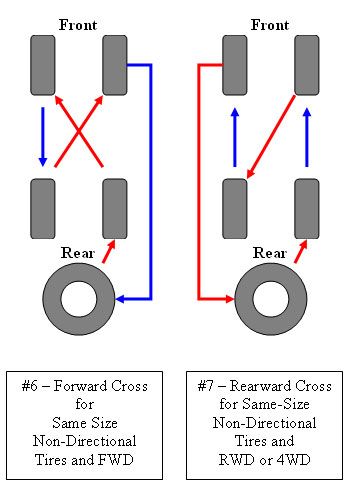 It's also a good time to check the condition of your wheel rims, which can be bent by hard impacts with potholes—sometimes only on the inboard side of the rim, where you can't easily see it.
It's also a good time to check the condition of your wheel rims, which can be bent by hard impacts with potholes—sometimes only on the inboard side of the rim, where you can't easily see it.
Two common tire problems that might surface during an inspection include cupping and blistering of the sidewall.
Getty Images
Tire cupping, Edmonds explains, is more common in older vehicles with suspension systems that are aging and in need of repair. This issue presents itself via uneven wear patterns in the tread, which, if ignored, could significantly affect a vehicle's ride, steering, and braking ability while also wearing out tires prematurely.
A blistered sidewall—literally, a bulge in the sidewall—might result from slamming into a deep pothole. "A tear might occur inside the tire when that tire gets pinched. The air could then get into the structure of the tire, and you get a blister," Edmonds says. If unseen or left undiagnosed, this problem could result in a flat tire or a blowout that could cause a serious accident. We suffered 10 pothole-related tire failures recently with one of our long-term test cars, a 2017 Jaguar XE, over the course of its 40,000-mile stay, due to Michigan's cratered road surfaces.
We suffered 10 pothole-related tire failures recently with one of our long-term test cars, a 2017 Jaguar XE, over the course of its 40,000-mile stay, due to Michigan's cratered road surfaces.
According to the Tire Industry Association, three tire-rotation patterns cover most of today's vehicles, as long as they are fitted with equal-size tires front and rear and those tires are not unidirectional (meaning they have to rotate in only one direction to function properly).
Rotation pattern for front-drive vehicles: Swap the front tires straight to the rear position on the same side. Take the rear tires and move them to the opposite front corner (e.g., the right rear tire gets moved to the left front).
Getty Images
Rotation pattern for rear-drive vehicles: Move the rear tires straight to the front, then move each front tire to the opposite rear corner (for example, move the right front to the left rear).
Rotation pattern for all-wheel-drive vehicles: Crisscross all four tires (move the right front to the left rear, the left front to the right rear, the left rear to the right front, and the right rear to the left front).
By the way, rugged-looking SUVs may be all the rage, but having a vehicle with all-wheel drive doesn't mean you're immune to tire-rotation maintenance. "That is a common misconception," says Edmonds, regarding the idea that all-wheel-drive vehicles automatically have tires that wear more evenly. "All-wheel-drive systems don't always drive all the wheels all the time," he explains, adding that transfer cases and electronically controlled differentials can shift power between the front and rear wheels, depending on the conditions and the drive mode that's been selected. And a vehicle's inherent weight difference between the front and rear can also affect tire wear.
Extra attention needs to be paid when it comes to vehicles with different wheel sizes at the front and rear and those fitted with unidirectional tires—tires that are designed to rotate in one direction only.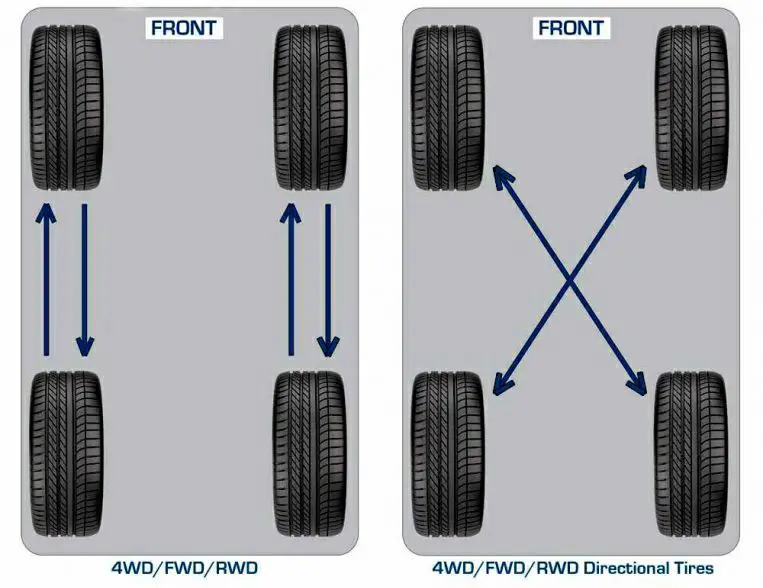 In many cases, this setup is used on high-performance vehicles, and tire-rotation patterns need to be adjusted to suit. In fact, some of these staggered-tire packages, as they are called, cannot be rotated unless the tires are dismounted and then remounted on the opposite-side wheels. In some cases it may not be worth the time, money, or trouble to rotate the tires.
In many cases, this setup is used on high-performance vehicles, and tire-rotation patterns need to be adjusted to suit. In fact, some of these staggered-tire packages, as they are called, cannot be rotated unless the tires are dismounted and then remounted on the opposite-side wheels. In some cases it may not be worth the time, money, or trouble to rotate the tires.
If you have any doubts about correct tire rotation, consult the owner's manual, inquire at a dealership, or talk to an expert who is familiar with your vehicle and its tires. But whatever you do, rotate them if possible. At the very least, it'll help your tires last longer and will save you money.
Now 15% Off
$119 at Amazon
Now 21% Off
$27 at Amazon
$68 at Amazon
$70 at Amazon
This content is imported from OpenWeb. You may be able to find the same content in another format, or you may be able to find more information, at their web site.
You may be able to find the same content in another format, or you may be able to find more information, at their web site.
Tires are one of the most important and ignored parts of a car. Properly maintained wheels keep your vehicle safe and performing well. Most drivers know regular rotations prolong the life of a set of tires, but how often should you rotate your tires? And why does it matter? Here’s how to properly care for your tires so they can take care of you.
Answer: You should rotate your tires every six months or 6,000 to 8,000 miles. Read more here: http://t.co/6aUv9vGOZ6 pic.twitter.com/vu34W11MsH
— Michelin USA (@MichelinUSA) February 7, 2015
When you take your vehicle to the mechanic to rotate the tires, each wheel is taken off the vehicle and moved to a different spot on the car. According to Michelin, tires are rotated to ensure they last longer, wear evenly, and keep you safe. Though every vehicle and tire type is different, many experts recommend tires be rotated at least every six months or every 6,000 to 8,000 miles.
According to Michelin, tires are rotated to ensure they last longer, wear evenly, and keep you safe. Though every vehicle and tire type is different, many experts recommend tires be rotated at least every six months or every 6,000 to 8,000 miles.
If you drive your vehicle a lot, you may need to get your tires rotated every time you need an oil change or every 3,000 to 5,000 miles. This time frame can vary, depending on whether your car is front-, rear-, or all-wheel drive. According to Car and Driver, tires will wear at different rates for various models. Proper rotation may also rely heavily on the type of tire, especially when it comes to vehicles with varying tire sizes at the front and rear.
Your vehicle’s owner’s manual should offer guidance on rotating your tires, as well as the rotation frequency and pattern of your vehicle. This can help you better understand how your tires wear and how often you need to rotate them. When in doubt, seek the advice of a professional.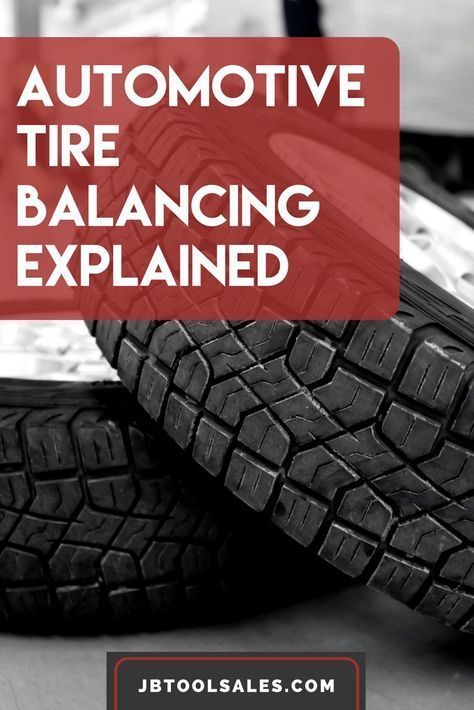
Rotating your tires is a task that should never be ignored. According to Consumer Reports, “Well-maintained tires will help you travel safely for tens of thousands of miles.” Without the proper rotation, your tires may not wear evenly, which can hinder your car’s performance and safety.
Your vehicle’s front tires are largely responsible for braking, which makes wheel quality even more important. If your tires are overly-worn or not evenly worn, your vehicle cannot do its job properly. Especially in the case of a front-wheel-drive car, which grips for traction, working to maintain even wear patterns can impact braking, overall ride, noise, and longevity.
If your tires are overly-worn or not evenly worn, your vehicle cannot do its job properly. Especially in the case of a front-wheel-drive car, which grips for traction, working to maintain even wear patterns can impact braking, overall ride, noise, and longevity.
In addition to maintaining your vehicle’s performance, rotating your tires can also have more practical value. For instance, if your tires come with a warranty, its maker may require regular maintenance to enforce the warranty. This requirement would include regular tire rotations.
Tire rotation also provides an opportunity for a mechanic to inspect your tires, access any damage, and even inflate them. Depending on the car, as well as its drivetrain, a mechanic will move your tires to different positions.
The most standard rotation, according to U.S. News, involves moving the front tires to the rear and the rear tires to the front. But there are a variety of rotation patterns, which makes seeking professional help necessary. During your vehicle’s inspection, the mechanic will also check for inflation rates and problems like blistering or cupping on your tires.
During your vehicle’s inspection, the mechanic will also check for inflation rates and problems like blistering or cupping on your tires.
Related materials
7 rubber signals: what the tire says about car problems
How do you know when tires are completely worn out and it's time to change them? Everything is simple. For summer tires, the limit is 1.6 mm of residual tread depth, and for winter (or all-season tires used in winter) - 4 mm. Modern summer tires can travel from 40,000 to 70,000 km, depending on driving style and vehicle characteristics. An average motorist rolls such a mileage on summer tires in 2-3 seasons. Moreover, wear implies not only a decrease in tread depth. For millions of cycles of deformation, the strength of the carcass and its adhesion to the layers of the rubber compound are violated. In short, every 2-3 years you should buy a new set of tires.
In case of irreparable damage to one of the tires and a relatively high total mileage of the kit, it is also worth considering replacing it.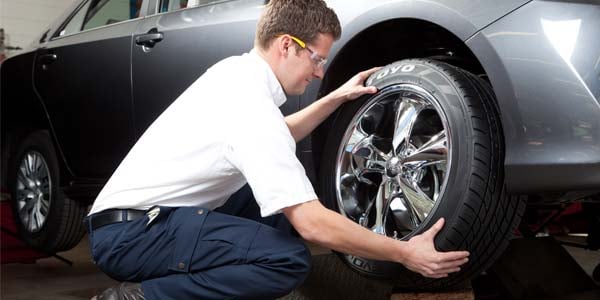 Well, or about buying at least a pair of new tires, which, for any type of drive, should be installed on the front axle. We put two tires back - the most decent of the remaining ones.
Well, or about buying at least a pair of new tires, which, for any type of drive, should be installed on the front axle. We put two tires back - the most decent of the remaining ones.
Many motorists drive only a few thousand kilometers a year. This does not mean that the tires will serve you for several decades. According to Russian requirements (GOST 4754-97), the service life of passenger car tires is 5 years from the date of manufacture. And for example, Continental recommends that all car tires (including the spare tire) older than 10 years old should be replaced with new ones. Therefore, with small runs, you can navigate for ten years. The date of manufacture of the tire is indicated on the sidewall. Usually it is an oval with four numbers. The first two are the ordinal number of the week in the year, the last two indicate the year.
Related materials
How to change the car yourself - detailed instructions
Tires should be rotated periodically in accordance with the vehicle manufacturer's recommendations - information on this can be found in the owner's manual.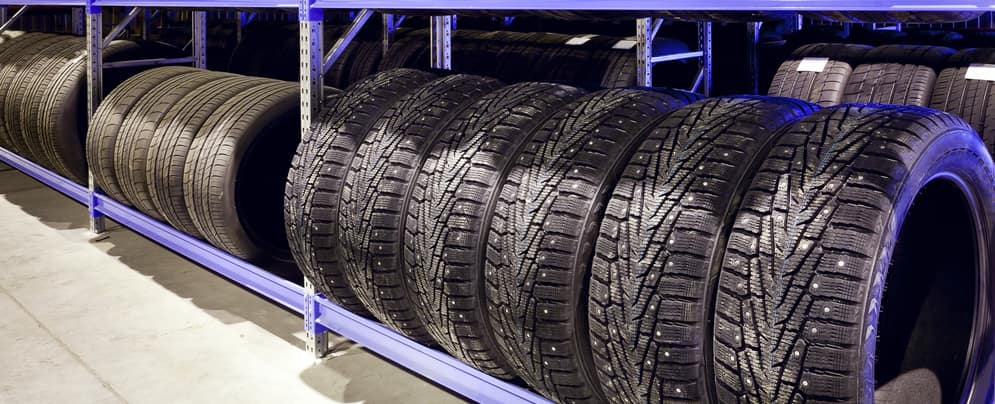
We can advise you to carefully use the tires and, most importantly, to store them correctly in the off-season. First of all, during storage, it is important to exclude direct sunlight from hitting the tires, which greatly age the rubber. Tires without rims should be placed vertically, and stacked on rims.
And before installing tires on a car at the beginning of the season, evaluate their condition. There should be no cracks in the tread and sidewalls. The tire should not be dry, it should remain rubbery and not look like baked plastic.
Related materials
Driving on badly worn tires - will I be fined or not?
Winter tires have a much shorter life span. They almost always fail due to the wear of the treadmill, because the tread of a new tire is 7–8 mm, and only 3–4 mm remain working height. If the tires are studded, then with such wear there are very few metal elements left, and the tire will not provide adequate safety when driving on a winter road.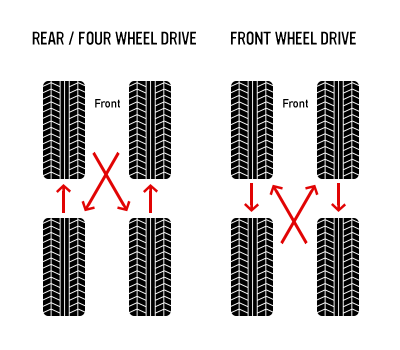 However, not only spikes, but also Velcro, with such a degree of wear, also lose most of their capabilities.
However, not only spikes, but also Velcro, with such a degree of wear, also lose most of their capabilities.
The real life of winter tires rarely exceeds 30,000 km. "Bald" winter tires without studs can be re-rolled in summer, but their grip on hot road surfaces will be very poor. This must be taken into account, especially when braking.
***
So: tires that have not yet worn out along the tread (that is, up to 1.6 mm tread depth for summer tires, 4 mm for winter tires) are changed either ten years after the date of issue, or when the rubber layer cracks tires or damage.
Our new video
Sleeper, laser in headlights... — what surprised the new Chinese crossover
New Lada Granta or Vesta with mileage — what to choose?
These 5 things should be in your car in winter. Do you have them?
Did you like the note? Subscribe and you will always be in the know!
Driving on Yandex.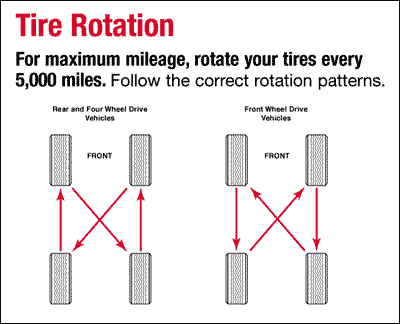 Zen
Zen
News smi2.ru
As we recommended back in the fall - when the average daily temperature rises above +5 C°. Under such conditions, the mixtures from which summer tires are made are already beginning to “work”, i.e. fully able to perform their functions. At the same time, in comparison with winter tires, summer tires save their owner not only fuel, but also a resource. After all, winter tires are heavier and wear out more at positive temperatures.
Does this mean that tires should be changed as soon as the snow melts? Not! It is important to be patient and wait not only for a steady "plus" during the day, but for the absence of night (and sometimes daily) short-term frosts that are quite possible in our climate. In this sense, as they say, it is better to "move".
This is especially true for those who travel on rural secondary roads (and icy yards). For city streets and highways from the highway are actively treated with anti-icing reagents.
For city streets and highways from the highway are actively treated with anti-icing reagents.
Technical regulation of the Customs Union "On the safety of wheeled vehicles" 018/2011, in particular paragraph 5.5, prescribes:
"It is forbidden to operate vehicles equipped with tires with anti-skid studs in the summer (June, July, August).
Vehicles not equipped with winter tires that meet the requirements of paragraph 5.6.3 of this annex during the winter season (December, January, February) are prohibited. Winter tires are installed on all wheels of the vehicle.
The terms of the prohibition of operation can be changed upwards by the regional government bodies of the member states of the Customs Union.»
Formally, following the letter of the law, owners of studded tires are obliged to change winter tires for summer tires only and only with the onset of June. However, taking into account the increased wear of winter tires at positive temperatures, higher fuel consumption and mediocre braking performance, it is better to change shoes from winter to summer in a timely manner.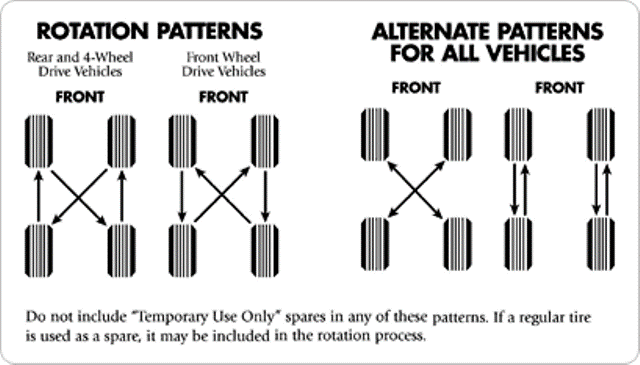 Cars equipped with studless winter tires can be used all year round. But, for the reasons described above, I do not recommend doing this. The author of these lines had a sad experience. Wheels with a 5-6 mm tread remaining were worn out almost over the summer. At the same time, the car noticeably “floated” at speeds of more than 100 km / h and an outboard temperature of more than +20 C. Of course, the sensations will be different from the control of the “fours” of the Zhiguli and BMW. A good car eliminates the negative consequences of using tires that are inappropriate for the season. But according to my personal feelings, properly selected tires allow not only to ensure safety, for example, on the same "seven" from AVTOVAZ, but to fully reveal the potential of the S7 from AUDI, charged with more than 400 horsepower.
Cars equipped with studless winter tires can be used all year round. But, for the reasons described above, I do not recommend doing this. The author of these lines had a sad experience. Wheels with a 5-6 mm tread remaining were worn out almost over the summer. At the same time, the car noticeably “floated” at speeds of more than 100 km / h and an outboard temperature of more than +20 C. Of course, the sensations will be different from the control of the “fours” of the Zhiguli and BMW. A good car eliminates the negative consequences of using tires that are inappropriate for the season. But according to my personal feelings, properly selected tires allow not only to ensure safety, for example, on the same "seven" from AVTOVAZ, but to fully reveal the potential of the S7 from AUDI, charged with more than 400 horsepower.
But back to the timing of the replacement. In your region (more southerly warm), the authorities may ban the use of winter tires, for example, from March to November. Or in the northern regions - to prescribe the use of winter tires from September to May. At the same time, the authorities at the regional level cannot limit the duration of the ban in force on the "union" territory: from December to February, cars throughout the territory of the Customs Union must use only winter tires, and from June to August - only summer tires.
Or in the northern regions - to prescribe the use of winter tires from September to May. At the same time, the authorities at the regional level cannot limit the duration of the ban in force on the "union" territory: from December to February, cars throughout the territory of the Customs Union must use only winter tires, and from June to August - only summer tires.
Thus, if we proceed strictly from the terms specified in the Technical Regulations, we get:
There is still a lot of controversy surrounding the statement: “It is better to have complete wheels than to have tires replaced every season”! Deformation of the onboard zone and sidewall cord is possible. In theory, it’s true - it’s cheaper, easier and more useful to change the wheels as an assembly: when the tire is mounted on the wheel (in everyday life - “disk”). In practice, my more than 20 years of experience and my friends (6-7 seasons already) have shown that nothing criminal happens with tires if tire fitting employees have the necessary and sufficient experience.